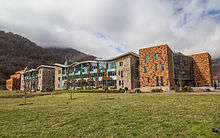Education in Armenia




In its first years of independence, Armenia made uneven progress in establishing systems to meet its national requirements in social services.[1] Education, held in particular esteem in Armenian culture, changed fastest of the social services, while health and welfare services attempted to maintain the basic state-planned structure of the Soviet era.[1]
A literacy rate of 100% was reported as early as 1960.[1] Even though the numeracy level was amongst the lowest in late eighteenth and nineteenth centuries, which might be an outcome of Ottoman and Persian educational policies that only gradually improved during the Russian period. [2] In the communist era, Armenian education followed the standard Soviet model of complete state control (from Moscow) of curricula and teaching methods and close integration of education activities with other aspects of society, such as politics, culture, and the economy.[1] As in the Soviet period, primary and secondary education in Armenia is free, and completion of secondary school is compulsory.[1] In the early 1990s, Armenia made substantial changes to the centralized and regimented Soviet system.[1] Because at least 98% of students in higher education were Armenian, curricula began to emphasize Armenian history and culture.[1] Armenian became the dominant language of instruction, and many schools that had taught in Russian closed by the end of 1991.[1] Russian was still widely taught, however, as a second language.[1]
In the 1990-91 school year, the estimated 1,307 primary and secondary schools were attended by 608,800 students.[1] Another seventy specialized secondary institutions had 45,900 students, and 68,400 students were enrolled in a total of ten postsecondary institutions that included universities.[1] In addition, 35% of eligible children attended preschools.[1] In the 1988-89 school year, 301 students per 10,000 population were in specialized secondary or higher education, a figure slightly lower than the Soviet average.[1] In 1989 some 58% of Armenians over age fifteen had completed their secondary education, and 14% had a higher education.[1] In 1992 Armenia's largest institution of higher learning, Yerevan State University, had eighteen departments, including ones for social sciences, sciences, and law.[1] Its faculty numbered about 1,300 teachers and its student population about 10,000 students.[1] The Yerevan Architecture and Civil Engineering Institute was founded in 1989.[1]
On the basis of the expansion and development of Yerevan State University a number of higher educational independent Institutions were formed including Medical Institute separated in 1930 which was set up on the basis of medical faculty. In 1980 Yerevan State Medical University was awarded one of the main rewards of the former USSR - the Order of the Red Banner of Labour for training qualified specialists in health care and valuable service in the development of Medical Science. In 1995 YSMI was renamed to YSMU and since 1989 it has been named after Mkhitar Heratsi, the famous medieval doctor. Mkhitar Heratsi was the founder of Armenian Medical school in Cilician Armenia. The great doctor played the same role in Armenian Medical Science as Hippocrates in Old Greek, Galen in Roman, and Ibn Sina in Arabic medicine. Foreign students' department for Armenian Diaspora established in 1957 later was enlarged and the enrollment of foreign students began. Nowadays the YSMU is a Medical Institution corresponding to international requirements, trains medical staff not only for Armenia and neighboring countries, i.e. Iran, Syria, Lebanon, Georgia but for many other leading countries all over the world. A great number of foreign students from India, Nepal, Sri Lanka, the USA and Russian Federation study together with Armenian students. Nowadays the university is ranked among famous higher Medical Institutions and takes its honorable place in the World Directory of Medical schools published by the WHO.
Other schools in Armenia include the American University of Armenia, QSI International School of Yerevan and Eurasia International University (EIU). EIU is a private higher education institution established in Yerevan, the Republic of Armenia, in 1996. On March 13, 1997 EIU was fully accredited based on the decision made by the Ministry of Science and Education of the RA. Since then EIU was authorized to issue State Diplomas. Starting from September 2007 Eurasia International University has fully conformed to the requirements of Bologna Process.
Student absenteeism

According to two studies carried out with the help of UNICEF – "Child Labour in Armenia" and "School Wastage Focusing on Student Absenteeism in Armenia" – a rapidly growing student absenteeism and drop out rate are closely linked to child labor as well as the quality of education in Armenia.[3] Between 2002 and 2005 school dropout rates grew at the rate of 250% a year. In 2002-2003 total dropouts were 1,531 students; in 2004-2005 this number increased to 7,630.[3]
See also
References
- 1 2 3 4 5 6 7 8 9 10 11 12 13 14 15 16 17 Curtis, Glenn E. and Ronald G. Suny. "Education". Armenia: A Country Study. Library of Congress Federal Research Division (March 1994). This article incorporates text from this source, which is in the public domain.
- ↑ Baten, Jörg (2016). A History of the Global Economy. From 1500 to the Present. Cambridge University Press. p. 51,52. ISBN 9781107507180.
- 1 2 Newly Appointed UNICEF Representative to Armenia – “Child labor robs children of their childhood itself”, Hetq Online, November 10, 2008.
External links
- Education in Armenia at DMOZ
- Education in Armenia, UNICEF country profile
- Vocational Education & training in Armenia, UNESCO-UNEVOC world TVET database